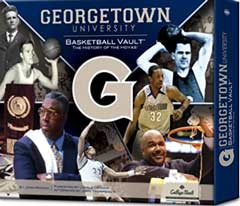"Georgetown University Basketball Vault:
The History of the Hoyas"

Georgetown University Basketball Vault: The History of the Hoyas
By: John Reagan
Publisher: Whitman
Date: November 9, 2010
Language: English
ISBN-10 : 0794828132
Hardcover, 144 pages
Much as the proverbial saying "Physician, heal thyself" is provocative, so too is the concept of an author reviewing his own work. But let's give it a go.
My interest in a history of Georgetown basketball began after my graduation from the University in 1984, and within two years I had come across an opportunity to build a prototype of a book detailing the history of the program, where proceeds would go back to the program as they did with Roland Lazenby's 1984 book on the championship season. I began work on what would grow to become a 298 page prototype, a mixture of season recaps and game highlights from 1907 through 1960.
In 1986, I met with Hoyas Unlimited director Greg Carroll and University PR spokesman Gary Krull, who were polite but largely incredulous that a 24 year old MBA student was proposing such an effort. What I did not know at the time was that the Lazenby book had not met internal sales targets and GU did not have the temperament for any new books about the basketball program, with my discussion having followed John Thompson's refusal to do a book with the Washington Post's John Feinstein which later became "Season On The Brink". My follow-up to Krull was greeted with what amounted to a cease-and-desist letter from the University, and that was that.
Twenty-two years later, I was contacted by Georgetown to do much the same thing proposed in 1986, and accepted the opportunity on the spot. The University had contracted with Whitman Publishing, an Atlanta-based firm which was marketing a program to athletic departments where it would publish histories of leading college football and basketball programs, with a sizable royalty available to the school for every copy sold. Athletic director Bernard Muir signed the deal, and now the book needed an author, and fast. I had 15 weeks to complete the work, and after a delay of one season by the publisher due to the 2009 recession, the Basketball Vault debuted in the fall of 2010.
Like many things in life, timing was everything. Muir signed the deal, but left Georgetown abruptly in the spring of 2009, whereupon the director of athletics position was vacant for almost a year. Had Muir not committed to it, it's likely GU would have held the proposal in abeyance for the new athletic director and by that time, Whitman began to move away from basketball in favor of football books on the Southeastern Conference, where larger fan bases were likely to buy more copies. The original plan was for a basketball book for each of the 13 Big East schools. In the end, only four were published: Connecticut, Louisville, Syracuse, and Georgetown.
I am mindful that readers of the Basketball Vault weren't buying it for the words. It is more of a coffee table book, with content supplemented by glossy photos from University Archives, many not seen in years, and a series of facsimile artifacts manually folded into its pages. "Fans will also discover never-before-published vintage photographs, artwork and memorabilia drawn from Georgetown's campus archives, including reproductions of old game programs, historic tickets, stickers and other amazing replicas tucked into dozens of pockets," reads the book's promotional copy. "You can examine a 1911 promotional poster, read a 1936 blurb about GU's win over NYU that broke the Violets' long winning streak and enjoy a card commemorating the Hoyas 1984 national championship." The intellectual property behind all these images was ably managed and licensed by Georgetown, and something that was altogether infeasible if I were to have done it on my own.
The timeline did not allow for any primary research. The 1986 manuscript helped formed a framework for the content of the older years and this web site's coverage of the modern era helped set a path for coverage of more recent seasons. In the end, it was a story with a timely ending--while the original 2009 publishing date would have ended with a struggle just to get to the NIT, the subsequent delay to the end of the 2009-10 season brought the reader to a season that saw Georgetown ranked as high as seventh nationally, with a Big East championship finals appearance and an NCAA berth.
As to what I would have changed in retrospect, very little. The Whitman series was set on a 144 page maximum so as to allow for the memorabilia to be added by hand in China, and the photos were a perfect match with the copy. A decade after its debut, I am gratified to be one of four authors of books on Georgetown basketball, and hope that copies of the book (and its story) survive for many years to come.